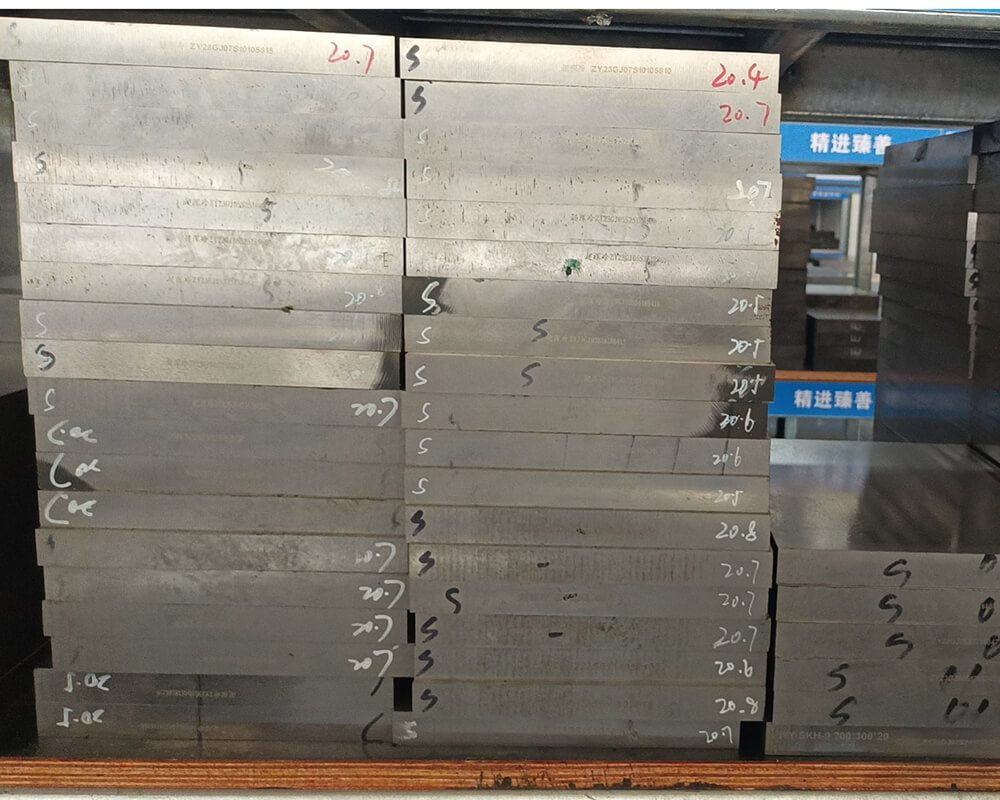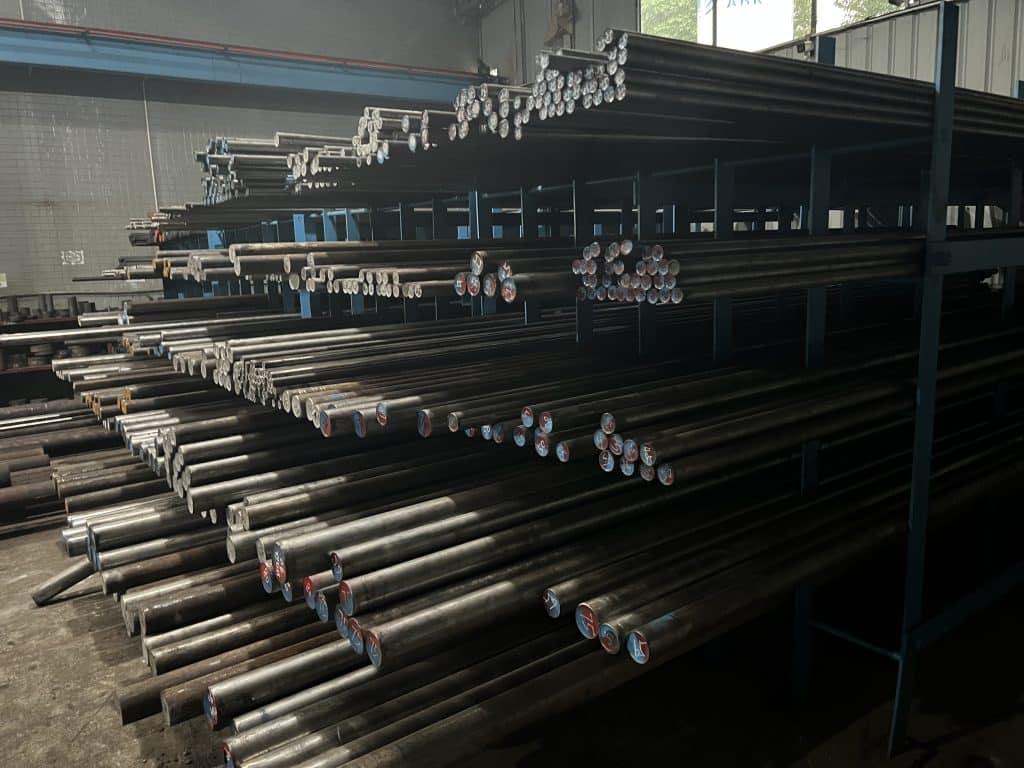Feedback from an old customer: When stretching 0.6-thick stainless steel edge ring made of Cr12MoV, it will fluff after a few pulls without adding oil. What’s going on? Replace by SKH51/M2 to solve it!
It can be said that if Cr12MoV mold steel is used to make a drawing mold or stainless steel, it must be roughened. It can also be said that this is a wrong material selection.
The following is a detailed description of Cr12MoV:
Cr12MoV is suitable for cold work die steel. The steel hardenability, quenching and tempering hardness, wear resistance, and strength are all higher than Cr12. It belongs to alloy tool steel. Various cold stamping dies and tools with complex shapes and heavy working conditions, such as punching dies, trimming dies, rolling dies, steel plate deep drawing dies, circular saws, standard tools and gauges, thread rolling dies, etc.
Availability status
The types of supplies include hot-rolled materials, forged materials, cold-drawn materials, hot-rolled steel plates and cold-drawn steel wires.
Corresponding brand
Chinese GB standard grade: Cr12MoV, German DlN standard material number 1.2601, German DIN standard grade x165CrM0v12, Japanese Jis standard grade sKD11, Korean Ks standard grade sTD11, Italian UN1 standard grade x165CrM0W12KU, Swedish SS standard grade 2310, Spanish UNE standard grade X160CrM0V12, American AISI/SAE standard grade D2, Russian roCT standard grade x12M.
Chemical composition:
Carbon C: 1.45~1.70
Silicon Si: ≤0.40
Manganese Mn: ≤0.40
Sulfur S: ≤0.030
Phosphorus P: ≤0.030
Chromium Cr: 11.00~12.50
Nickel Ni: Allowable residual content ≤0.25
Copper Cu: Allowable residual content ≤0.30
Vanadium V: 0.15~0.30
Molybdenum Mo: 0.40~0.60
It is produced by electric furnace vacuum refining, forged and blanked, with uniform eutectic carbides, high hardenability, high wear resistance, high toughness, and small volume deformation during quenching; therefore, its market usage is very large.
1. Reduce the content of Cr, Mo, and V elements, directly reduce costs, and also seriously affect performance, such as using Cr8 and Cr12 as Cr12MoV;
2.Change its production method, use intermediate frequency furnace instead of electric furnace for refining, resulting in too many impurities in the ingredients, use continuous casting method instead of spheroidizing annealing, reduce rolling ratio and other methods to reduce costs. The final customer will not be able to use the material when using it. The expected effect is that the mold life is reduced, and severe cases directly lead to cracking and scrapping.
Mechanical properties:
Hardness: annealed, 255~207HB (14-25HRC), indentation diameter 3.8~4.2mm; quenched, ≥60HRC
Cr12MoV application
Cr12MoV mold steel has higher hardenability, hardness, strength and toughness after quenching and tempering than CR12. Workpieces with diameters below 300~400mm can be completely quenched, with small quenching deformation, but poor high-temperature plasticity. Cr12MoV is mostly used to manufacture composite molds and tools with large cross-sections, complex shapes, and heavy workloads. Such as punching die, trimming die, rolling die, steel plate, etc.
Heat treatment specifications
Heat treatment specifications: 1. Quenching, oil cooling at 950~1000℃; 2. Quenching at 1020℃, tempering at 200℃ for 2 hours.
Metallographic structure: fine-grained pearlite + carbide.
Delivery condition: Steel is delivered in annealed condition.
Specification for softening of cold extruded blanks
Use iron filings to protect and heat, temperature 760~780°C, time 10h, furnace cooling, hardness l96HBW, cold extrusion forming can be achieved smoothly
General isothermal spheroidizing annealing specifications
850~870℃×3~4h, then cool to isothermal temperature of 740~760℃×4~5h, air cooling after coming out of the furnace.
Hardness ≤241HBW, eutectic carbide grade ≤3
Optimum isothermal temperature 740~76o°C, time ≥4~5h
Spheroidizing Annealing Specifications
(860±1ü)°C×2~4h, furnace cooling at 30°C/h cooling rate, (740±10)°c x4-6h, slowly cooled in the furnace to 500~600°C, air cooled after coming out of the furnace. Hardness 207 ~255HBW.
Cryogenic treatment
Cr12MoV steel is cryogenically treated.
The cryogenic treatment can cause the quenched martensite to precipitate highly dispersed ultrafine carbides.
After subsequent low-temperature tempering at 200°C, these ultrafine carbides can be transformed into carbides.
Martensite without cryogenic treatment will only precipitate a small amount of carbides in certain local areas after low-temperature tempering.
Cr12MoV adopts low-temperature chemical heat treatment method. On the basis of maintaining the high hardness and high wear resistance of Cr12MoV steel, the adhesion resistance of the infiltration layer is improved by low-temperature chemical heat treatment commonly used in ion nitriding, gas nitrocarburizing, and salt bath thiocyanate co-infiltration.
The three types of low-temperature chemical heat treatment infiltration layers all have significant impact resistance and adhesion effects, among which the salt bath thiocyanate co-infiltration is the best.
After gas nitrocarburizing treatment, the service life of the Cr12MoV steel stainless steel vessel drawing mold reaches more than 30,000 pieces, which is more than 10 times longer than that of similar molds treated with conventional quenching and tempering.
Hardened
In order to increase the mold life to more than 800,000 mold times, the pre-hardened steel can be hardened by quenching and low-temperature tempering. When quenching, first preheat at 500-600℃ for 2-4 hours, then keep it at 850-880℃ for a certain time (at least 2 hours), put it in oil and cool it to 50-100℃, then cool the oil in the air. After quenching, the hardness can reach 50 -52HRC, in order to prevent cracking, it should be immediately tempered at 200℃ at low temperature. After tempering, the hardness can remain above 48HRC.
Salt bath vanadium infiltration treatment
Neutral salt bath vanadium infiltration treatment process of Cr12MoV cold work die steel.
Cr12MoV steel can obtain carbide infiltration layer by neutral salt bath vanadium infiltration treatment.
1. Carbon vanadium compound. The infiltration layer has a uniform structure, good continuity and Dense, uniform thickness, dense structure, high microhardness and high wear resistance, surface hardness, wear resistance and anti-adhesion properties are greatly improved.
2. The solubility of VC in austenite is higher than that in ferrite. As the temperature decreases, VC precipitates from the ferrite, strengthening the alloy and refining the grains, and the compound layer shows higher of hardness.
Cr12MoV is a high-carbon, high-chromium ledeburite steel with a high carbide content, accounting for about 20%, and is often unevenly distributed in a strip or network shape, causing serious segregation.
However, conventional heat treatment is difficult to change the carbide segregation situation, which is serious. Affects the mechanical properties of the steel and the service life of the mold. The shape and size of carbides also have a great impact on the properties of steel.
In particular, large, sharp-cornered carbides have a greater effect on splitting the steel matrix and often become the source of fatigue fracture.
For this reason, the raw material rolled steel must be processed. Modify the forging to fully crush the eutectic carbides so that they are fine and evenly distributed, and the fiber structure is distributed around the cavity or in a non-directional manner, thereby improving the lateral mechanical properties of the steel.
During forging, the steel billet is upsetting and drawn multiple times from different directions, and the “two light and one heavy” method is used for forging, that is, the billet should be lightly struck when starting to be forged to prevent breakage, and it can be struck hard at an intermediate temperature of 980 to 1020°C. To ensure the carbide is broken.
Cr12MoV steel is not forged and adopts solid solution double refinement treatment, that is, two-level preheating at about 500 ℃ and 800 ℃, solid solution treatment at 1 100 ~ 1 150 ℃, quenching in hot oil or isothermal quenching, and high temperature of 750 ℃ Tempering, after machining, heating oil at 960 ℃ and then performing final heat treatment can also refine carbides, round edges and corners, and refine grains.
General quenching and tempering specifications:
Quenching temperature 1000~1050℃, quenching oil or quenching gas, hardness ≥ 60HRC; tempering temperature 160~180℃, tempering time 2h, or tempering temperature 325~375℃, tempering times 2~3 times.
Usual specification
Cr12MoV|Φ10 cold work die steel
Cr12MoV|Φ11 cold work die steel
Cr12MoV|Φ12 cold work die steel
Cr12MoV|Φ13 cold work die steel
Cr12MoV|Φ14 cold work die steel
Cr12MoV|Φ15 cold work die steel
Cr12MoV|Φ16 cold work die steel
Cr12MoV|Φ17 cold work die steel
Cr12MoV|Φ18 cold work die steel
Cr12MoV|Φ19 cold work die steel
Cr12MoV|Φ20 cold work die steel
Cr12MoV|Φ21 cold work die steel
Cr12MoV|Φ22 cold work die steel
Cr12MoV|Φ23 cold work die steel
Cr12MoV|Φ24 cold work die steel
Cr12MoV|Φ25 cold work die steel
Cr12MoV|Φ26 cold work die steel
Cr12MoV|Φ28 cold work die steel
Cr12MoV|Φ29 cold work die steel
Cr12MoV|Φ30 cold work die steel
Cr12MoV|Φ32 cold work die steel
Cr12MoV|Φ35 cold work die steel
Cr12MoV|Φ38 cold work die steel
Cr12MoV|Φ40 cold work die steel
Cr12MoV|Φ42 cold work die steel
Cr12MoV|Φ45 cold work die steel
Cr12MoV|Φ48 cold work die steel
Cr12MoV|Φ50 cold work die steel
Cr12MoV|Φ52 cold work die steel
Cr12MoV|Φ55 cold work die steel
Cr12MoV|Φ60 cold work die steel
Cr12MoV|Φ65 cold work die steel
Cr12MoV|Φ70 cold work die steel
Cr12MoV|Φ75 cold work die steel
Cr12MoV|Φ80 cold work die steel
Cr12MoV|Φ85 cold work die steel
Cr12MoV|Φ90 cold work die steel
Cr12MoV|Φ95 cold work die steel
Typical examples
1. This steel can be used to make complex-shaped punches, concave molds, and inserts for punching molds with material thickness >3mm. The recommended hardness is 58~62HRC when making punches, and the recommended hardness is 60~64HRC when making concave molds.
2. Used to make punches and concave dies that require high wear resistance in punching molds. When making punch molds, the recommended hardness is 60~62HRC, and when making concave molds, the recommended hardness is 62~64HRC.
3. Used to make concave dies that require tensile strength in drawing dies. The recommended hardness is 62 ~ 64HRC.
4. Used to make punches, concave dies and inserts that require wear resistance and complex shapes in bending dies. The recommended hardness is 60~64HRC when making punch molds, and the recommended hardness is 60~64HRC when making concave molds.
5. Used to make punches and concave dies for cold extrusion of aluminum parts. The recommended hardness is 60~62HRC when making punch molds, and the recommended hardness is 62-64HRC when making concave molds.
Cr12MoV inspection methods:
1.Detect the core element content and components;
2.According to the wear resistance test and carbide level measurement, the hardness after quenching is less than the national standard requirement of HRC58;
Cr12MoV is used to manufacture various cold stamping molds and tools with large cross-sections, complex shapes and heavy working conditions, such as punching dies, trimming dies, rolling dies, steel plate deep drawing dies, circular saws, standard tools and gauges, thread rolling mold, etc.
Because Cr12MoV is a high-carbon cold-work die steel with a carbon C content of about 1.5%. For materials with high carbon content, the structure will form carbide segregation. Once carbide segregation occurs in the die steel, invisible to the naked eye will form on the structure. Microscopic hairline cracks and microscopic unevenness.
During the stretching process, the uneven surface will scratch the surface of the stainless steel when it comes into contact with the stainless steel; fine cracks will cause adhesive wear with the stainless steel, resulting in scratches on the mold and burrs on the product.
Therefore, using Cr12MoV as a mold to stretch stainless steel is a problem that cannot be cured, and the only way is to change the material.
The stainless steel drawing mold must use at least high-speed steel SKH51 or M2 (1.3343 / KM-2) hardness HRC62-64, or powdered high-speed steel PM2323. Of course, carbide is also very good.

Below are the details of SKH51/M2:
SKH51 is used to manufacture various forming tool products. The steel has high red hardness and can withstand high temperatures of 600°C and is not easy to soften. The hardness can reach 64HRC. The wear resistance is 2 times higher than high chromium steel and the toughness is 1.5 times stronger. However, the heat treatment process It is difficult and costly. Excellent toughness and impact resistance.
Disadvantages: The heat treatment process is difficult and costly
Chemical composition: (%) C0.9, Cr4.2, Mo5.0, W6.3, V1.9, a small amount of Co
Performance: high toughness, excellent cutting performance, good thermoplasticity, good wear resistance
Characteristics of SKH51/M2 mold steel:
M2 tungsten-molybdenum is a tough high-speed steel with fine and uniform carbide particles, high toughness, excellent cutting performance, good thermoplasticity, and good wear resistance. M2 steel has high red hardness, can withstand high temperatures of 600°C and is not easy to soften. Its hardness can reach 64HRC. Its wear resistance is 2 times higher than high chromium steel and its toughness is 1.5 times stronger. However, the heat treatment process is difficult and costly. Excellent toughness and impact resistance.
Supply state and hardness annealed state, hardness ≤240HBS.
Refer to the corresponding steel number
Chinese standard steel number SKH51,
American AISI standard steel number M2,
German Dewei GS standard steel number GS388 / 1.3343,
Japanese JIS standard steel number SKH51.
Quenching and tempering specifications
The first preheating temperature is 550~600℃, and the holding time is 25~30mim/25mm.
The second preheating temperature is 850~900℃, and the holding time is thickness (mm) × 20s.
The austenitizing temperature is 1190~1230℃, the holding time is thickness (mm) × 20s, then quenched (air cooling/salt bath/oil) to 250~300℃, and air cooled to about 50℃ after being released.
Tempering temperature 560℃, tempering 3 times. Each tempering operation takes 1 to 2 hours.
Typical application examples
1.Long-life cold punching dies and high-speed blanking dies.
2. ≤6mm silicon steel sheet, stainless steel sheet and high carbon steel sheet punching and cutting, precision punching dies and punches.
3. Various high-precision, long-life and wear-resistant standard punches, special punches and thread rolling tools and other products.
4.It is also suitable for manufacturing various molding tools, such as cold extrusion heads and extrusion dies.
5.High-precision plastic molds and etc.

